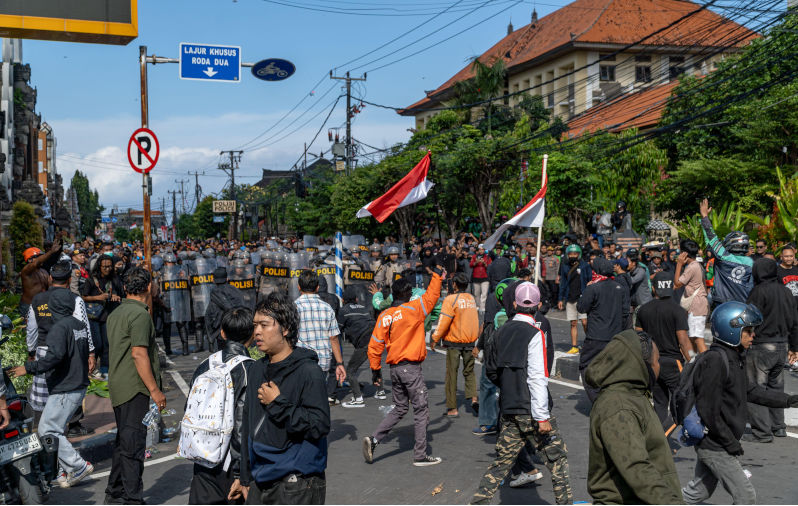Protest wave challenges Indonesia’s authoritarian drift
November 1, 2025
In late August 2025, Indonesia was shaken by a wave of protests following the death of Affan Kurniawan, a motorcycle taxi (“ojek”) driver who was struck and killed by a police tactical vehicle during demonstrations. His death became the spark for mass mobilisations across several cities.
The state responded with repressive measures like police violence, mass arrests of activists and military intimidation. Eleven people have died, hundreds have been injured and many activists, such as Lokataru’s director Delpedro Marhaen, remain detained on vague charges. These events raise a critical question about what Indonesia’s escalating protests mean for Indonesia’s democratic trajectory amid autocratisation.
The August protests can be traced back to Pati, a regency in Central Java. Thousands of Pati’s citizens demanded the resignation of regent Sudewo after a staggering 250% rise in property taxes. The increase followed deep budget cuts imposed by President Prabowo Subianto’s administration, which reduced fiscal transfers to local governments.
Amid the budget cuts, the elites showed insensitivity and inequity, which fed widespread discontent. Public anger deepened when parliament raised its own salaries to 44 times the Jakarta minimum wage. Instead of dialogue, the state opted for coercion – producing a chain reaction of anger, violence and repression.
This trajectory highlights concerns raised by scholars who argue that Indonesia is experiencing not only democratic backsliding but a serious democratic erosion. In 2019, Warburton and Aspinall detected democratic regression rooted in the failure to exclude anti-democratic figures and in citizens’ superficial support for democracy. After the 2024 elections, Jaffrey and Warburton suggest Indonesia is edging towards “competitive authoritarianism”, borrowing Levitsky and Way’s typology. The latest 2025 V-Dem democracy report places Indonesia in the “grey zone”, indicating it no longer meets the minimum standards of electoral democracy.
The democratic decline can be traced back to the 2017 Jakarta gubernatorial election, when sectarian mobilisation by illiberal-leaning Islamists against Basuki Tjahaja Purnama (Ahok) reshaped the political landscape. President Joko Widodo responded to Islamist mobilisation with repression – what Marcus Mietzner calls “ fighting illiberalism with illiberalism”. The approach extended beyond Islamist groups to other arenas of civil society.
Key democratic institutions were weakened. The Corruption Eradication Commission was gutted and the 2020 Job Creation Law reinforced oligarchic entrenchment. The 2024 election was tainted by constitutional manipulation that enabled Jokowi’s son, Gibran Rakabuming, to run as Prabowo’s vice-presidential candidate. Misuse of state resources and police intervention sealed the outcome. The result, as many feared, was a government with weak governance capacity and limited democratic commitment, deepening democratic erosion.
Research by Shadmehr and Boleslavsky suggests repression can backfire when legitimacy is uncertain, fuelling broader mobilisation. This dynamic is visible when peaceful dissent is met with police repression. In Indonesia, Kurniawan’s death turned coercion into a catalyst for mobilisation rather than a deterrent, further delegitimising the regime’s repression.
Whether these protests can shift Indonesia’s democratic trajectory depends on organisation. As Kurt Weyland argues, structured and organised democratic movements typically produce slower but more durable transitions. In contrast, unorganised protests risk providing a pretext for greater authoritarian entrenchment, even the imposition of martial law – a possibility floated in media reports after the riots and looting that accompanied Indonesia’s wave of protests.
Indonesia’s own history offers lessons. The Reformasi movement of 1998, though marred by violence and minority persecution, achieved a stable and more enduring democratic transition. This transition occurred largely because it involved organised networks of students, civil society and mass organisations.
The August protests of 2025 show early signs of expanding beyond spontaneous anger towards more organised and durable action. Indonesian diaspora groups worldwide have mobilised in solidarity, while initiatives such as the “ 17+8 People’s Demands” attempt to consolidate grievances from different civil society actors. If this momentum can be sustained and organised, the protests could become a vehicle for improving Indonesia’s democratic trajectory. But risks of fragmentation, repression and authoritarian retrenchment remain stark.
Indonesia’s current wave of protests reflects more than anger over local taxation or elite privilege. It embodies accumulated frustrations with elites’ insensitivity, oligarchic capture and democratic erosion. The protests highlight two dynamics – exposing the declining legitimacy of state coercion and the emerging possibility of democratic renewal in Indonesia. If civil society consolidates demands into an organised and broad-based movement, Indonesia may yet rediscover the spirit of Reformasi and push back against backsliding. But if the protests remain fragmented, the state’s coercive apparatus could instead entrench a more militarised authoritarian order.
Republished from East Asia Forum, 20 October 2025
The views expressed in this article may or may not reflect those of Pearls and Irritations.
